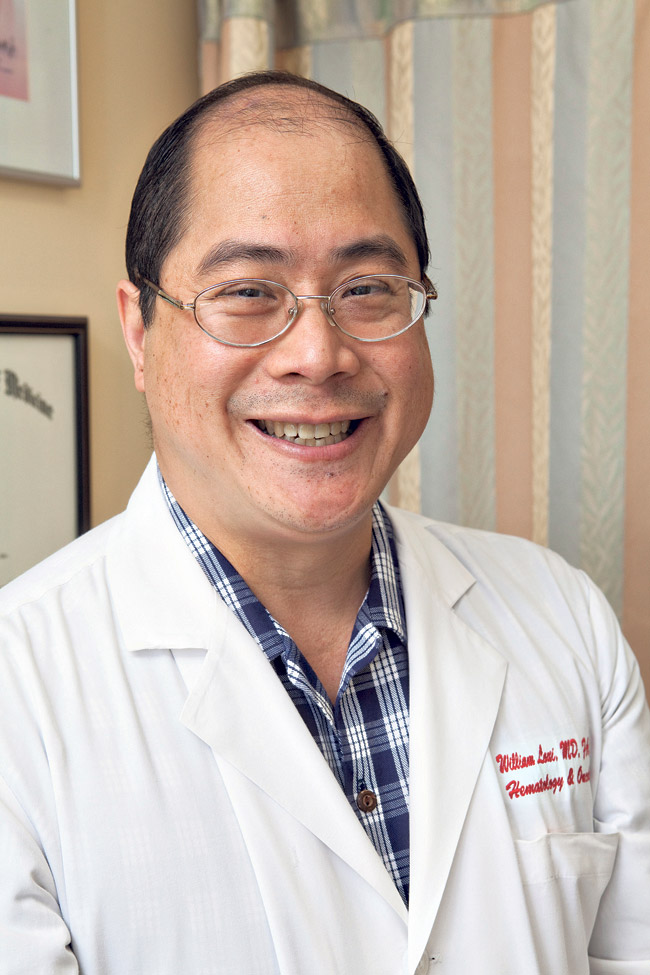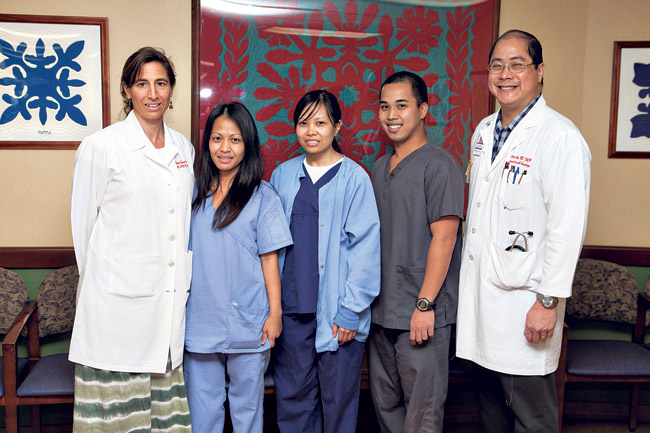Cancer: ESL, Teleconference Help
Dr. William Loui
Oncologist
Where did you receive your schooling and training?
I went to the University of Hawaii School of Medicine. After graduating from medical school I went to Mayo Clinic in Minnesota and did my internal medicine training, and then specialty training in hematology and oncology. I also did a bone marrow transplant fellowship at City of Hope in California. I was doing bone marrow transplants in Los Angeles for about five years before I came back home to Hawaii in 2000.
dih_2
Do oncologists only deal with cancer?
Cancer is our specialty. Some also deal with lymphomas and leukemias. We also have a separate specialty, hematology, which talks about blood diseases that are benign like coagulation or bleeding disorders, and also malignancies such as lymphoma or leukemia.
You were honored for your accomplishments in the medical field at the Susan G. Komen inaugural Pink Tie Ball earlier this year, and you also just received national certification for Quality Oncology Practice Initiative. Can you talk about those two honors?
I am a private practitioner in Hawaii, treating cancer. I served as the chief of the oncology department at Queen’s Medical Center for the past three years until this past July, also as chief of the Cancer Institute at St. Francis Medical Center, and chief of oncology for Molokai General Hospital. I was the bone marrow transplant director at the Hawaii Medical Center, and at the St. Francis Medical Center before that. I’m also faculty at John A. Burns School of Medicine at UH. Another hat is assistant clinical professor at the University of Hawaii Cancer Center. I firmly believe in giving back to the community. I’m a volunteer at the American Cancer Society on the board of directors.
The Quality Oncology Practice Initiative (QOPI) is a national quality program from the American Society of Clinical Oncology. There are more than 90 quality indicators. To be certified, you have to submit your performance data and be independently audited. Our group, OnCare Hawaii, is the only QOPI-certified group in Hawaii. This is a real honor because you’re compared to national benchmarks. We are the 100th certified practice in the nation! So it is fair to say we are in the top 100 oncology groups in America. This is a recognition of the superior quality of care we provide to people in Hawaii.
What area of oncology do you specialize in?
I take care of people who have blood disorders and cancers of all types. One specialty has to do with regenerative medicine. Stem cells have gotten a lot of controversy because people think only of embryonic stem cells, which is the fertilized cell. But we get stem cells from fat cells and stem cells that are floating around in your blood. There’s a tremendous interest and potential for regenerative medicine using stem cells in a whole variety of illnesses.
How are the stem cells extracted?
We collect a donor’s blood and spin off the cells that we want, like skimming off the cream. Then everything else gets returned to the donor. It’s all closed and sterile, it doesn’t get mixed with anyone else’s blood. Usually the biggest side effect is it’s boring. It takes about six to eight hours.
You also reach out to patients who don’t speak English.
Communication is a key part in cancer care. When working with so many groups and languages, we struggle to make things understandable. In response to this need, we developed a DVD for Filipinos in Tagalog and Ilocano languages about cancer – breast cancer, lung cancer, colon cancer, thyroid cancer, liver cancer. We use the DVD for people to understand more about cancer. We got a grant to develop, produce and distribute the DVD and we’re going to eventually give everyone access to that information. We have worked with Asian American Network for Cancer Awareness, Research and Training on an updated DVD describing the importance of clinical trials in Tagalog and Ilocano. We are currently testing the effectiveness and will come out with a final version soon.
It’s part of returning something to the community and part of the volunteering that I do.
The DVD is available through the University of Hawaii Cancer Center and we’ve distributed it to all hospitals. We also sent a bunch to Molokai and Guam. We do something else that’s innovative with Molokai. We have televideo confer-encing for people who have cancer and have to come to Oahu regularly, like every two weeks, or even every week for chemotherapy. Now, they can have their first evaluation treatment on Oahu and the rest of the treatments on Molokai, and we work with them solely through televideo confer-encing.
Does teleconferencing help with the actual treatment?
We use the televideo conferencing at Queen’s Medical Center and connect with Molokai General Hospital. Thus, we can speak face to face with patients, nurses and doctors. This close collaboration enables people to get the care they need with their family doctors on Molokai while being monitored by cancer specialists in Honolulu.
We actually have people who say, “I would rather not get treatment, I would rather die from the cancer than have to travel back and forth, back and forth from Molokai.” Teleconferencing has worked really nicely, it’s a good service that we do. We actually had a presentation in front of the chairman of the Federal Communications Commission. This was through Sen. Daniel Inouye’s office. We also had someone from the Native American Communication Office come down. He saw a conference in the morning from Queen’s Medical Center on Oahu and then flew to Molokai and saw what it looked like from the other side at Molokai General Hospital with another patient’s conference. Something we’ve done as well is extend a monthly televideo conference for survivorship from Queen’s Medical Center Cancer Center out to Molokai General Hospital.
I remember this one lady who was on Kalaupapa and had to travel up the trail every two weeks, fly out that day, get treatment the next morning, fly back and go back down the trail. And she did that for more than a year. If you’re flying on a little airplane and you don’t feel so good and it’s getting bumpy, well, you get the picture. With teleconferencing, she doesn’t have to do that. We’ve tried very hard to make sure that people who are on Neighbor Islands have access to the specialty care that they might not otherwise have. This helps address health care disparity, notably access care. Unlike other states, patients from rural areas on the Neighbor Islands can’t get in their cars and drive over for cancer care.







